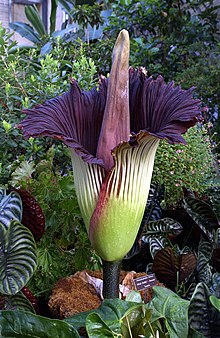Dunalia
| Amorphophallus | |
|---|---|
 |
|
| Titan arum (Amorphophallus titanum) is the Amorphophallus with the largest inflorescence | |
| Scientific classification | |
| Kingdom: | Plantae |
| (unranked): | Angiosperms |
| (unranked): | Monocots |
| Order: | Alismatales |
| Family: | Araceae |
| Subfamily: | Aroideae |
| Tribe: | Thomsonieae |
| Genus: |
Amorphophallus Blume ex Decne. |
| Synonyms | |
|
|
Amorphophallus (from Ancient Greek amorphos, "without form, misshapen" + phallos, "penis", referring to the shape of the prominent spadix), commonly known as Zaminkand, is a large genus of some 200 tropical and subtropical tuberous herbaceous plants from the Arum family (Araceae), native to Asia, Africa, Australia and various oceanic islands. A few species are edible as "famine foods" after careful preparation to remove irritating chemicals.
The oldest systematic record of the plants was in 1692, when Van Rheede tot Drakenstein published descriptions of two plants. The name "Amorphophallus" was first mentioned in 1834 by the Dutch botanist Blume. Between 1876 and 1911, Engler merged a number of other genera into Amorphophallus, with a final monograph published in 1911.
These are typical lowland plants, growing in the tropical and subtropical zones of the paleotropics, from West Africa to the Pacific Islands. None of them are found in the Americas although a remarkably similar but not closely related genus, Dracontium, has evolved there. Most species are endemic. They grow preferentially on disturbed grounds, such as secondary forests.
These small to massive plants grow from a tuber. Amorphophallus tubers vary greatly from species to species, from the quite uniformly globose tuber of A. konjac to the elongated tubers of A. longituberosus and A. macrorhizus to the bizarre clustered rootstock of A. coaetaneus. From the top of this tuber a single leaf, which can be several metres across in larger species, is produced atop a trunk-like petiole followed, on maturity, by a single inflorescence. This leaf consists of a vertical leaf stalk and a horizontal blade, which may consist of a number of small leaflets. The leaf lasts one growing season. The peduncle (the primary flower stalk) can be long or short.
...
Wikipedia
